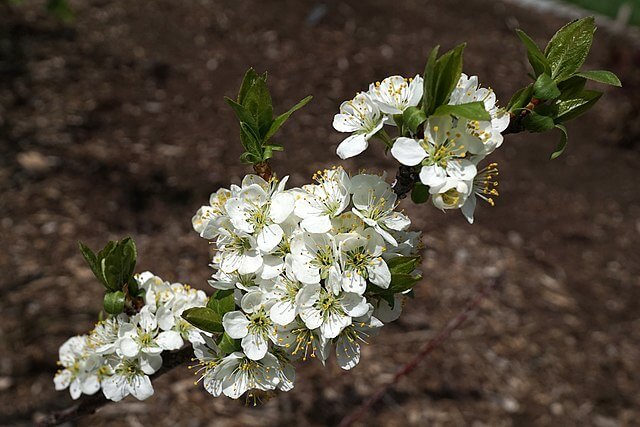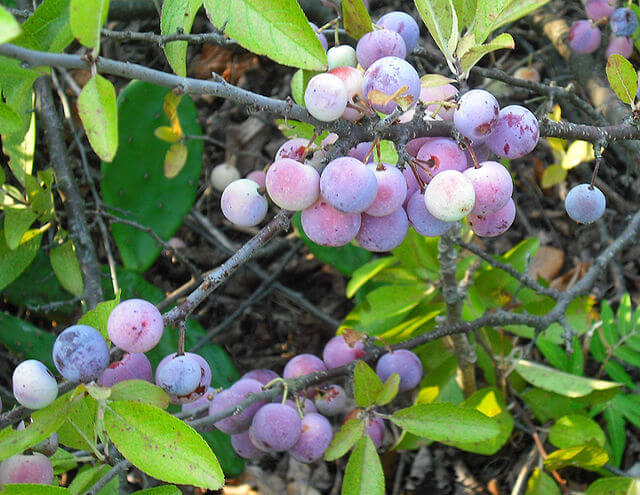The beach plum, Prunus maritima, is a unique fruiting shrub native to America’s northeastern shoreline. A member of the Rosaceae (rose) family, and also known as the seaside or sand plum, early settlers and Native Americans relied on the plant’s tart fruits as a late fall food source. Since it is a perennial shrub, our ancestors could count on fresh meals and preserves around its fruiting season year after year. Foragers can find beach plum growing wild along sand dunes and in sandy soil slightly inland from the coast.

Beach plum is a woody shrub growing around six feet wide and tall. Its egg-shaped, deep green leaves sport fine-toothed edges and display a stunning array of yellow, orange, and red colors in the fall. One of the most distinctive aspects of beach plum is its prolific growth of flowers during the late spring. The small, white flowers bloom densely and, sometimes, take on a pinkish hue once visited by a pollinator. Beach plum’s blooms wilt as small, round green fruits take their place. When early fall arrives, the fruits darken to a blue or purplish color and form a powdery coat called a ‘bloom’—as do most other plum species. The ‘bloom’ forms to protect the fruits from insects or drying out and is completely edible, though it wipes off easily if you prefer to pass it up.
Edibility and Culinary Use
The flesh and skin of the fruit are both edible, though the skin is often considered to be bitter. The green flesh of the beach plum fruit is where its sweetness lies, but there is frustratingly little of it due to the fruit’s large seed. Early settlers used beach plums to make jams, jellies, and even fermented drinks—though their strangest uses for a modern palate would be as additions to meat and seafood dishes. The tradition of early fall canning of beach plum preserves continues on in the northeast, and the jams fetch a high price at local farmer’s markets.
Medicinal Uses of Beach Plum
Beach plums have been used for centuries as a preventative and treatment for urinary tract infections. Scientists have found the fruits to contain antibacterial compounds, lending credibility to this old folk cure. Promising studies have found that beach plums may contain antioxidant properties, though more studies are needed to determine definitive uses.

Cautions
There is a specific and crucial caution surrounding the consumption of beach plums: their seeds. Each fruit contains one large seed, and like most members of the plum family, these seeds contain cyanide. It is important to avoid ingesting the seeds of these fruits, as they may be toxic if enough cyanide is consumed. Another cautionary tale comes from the fruit’s toxicity to some animals. Livestock and dogs have been observed developing severe illnesses after ingesting beach plums, so be cautious if your pup comes on foraging trips with you. Beach plum can be confused with another coastal fruit bearing shrub, the sand cherry, though this shrub only grows two feet tall and sports slender leaves. If you manage to get these fruits mixed up, the sand cherry is edible as well. However, as a forager, you must always be confident in your identification to ensure safety.
Conclusion
The beach plum plant is a native species with a rich history surrounding our survival. Its traditional uses are still observed today, despite the work required to reap the rewards of this small fruit. Its promising medicinal potential is awaiting further study, but its importance to the formation of our nation cannot be understated. Should you choose to forage for beach plums, be sure to practice sustainable foraging by caring for the fragile and vital dunes it thrives on.
Many of our readers find that subscribing to Eat The Planet is the best way to make sure they don't miss any of our valuable information about wild edibles.
See our privacy policy for more information about ads on this site






